At a meeting with City officials, on March 9, 2020, hosted by the Friends of Swan Lake Park, the 180 attendees were asked to fill in a survey on their views about the current conditions in Swan Lake and Swan Lake Park and their preferences for a long term solution.
The follow results summarize the responses from 98 Swan Lake Village residents and one other attendee on the key issues discussed at the meeting.
The survey results will be shared with the City of Markham by the Friends of Swan Lake Park in support of their efforts to save Swan Lake and Swan lake Park by encouraging the City to pursue long term sustainable solutions.
Health Risks
There are moderate levels of cyanobacteria in Swan Lake. Cyanobacteria can be harmful to humans and deadly for small animals. 85% of respondents said they were very concerned about the possible health risks while another 14% indicated they were somewhat concerned. Only 1 respondent replied that they were not concerned about the possible health risks.
When asked their views on what temporary measures the City should enact until the cyanobacteria risks are lowered, 97% felt posting of health risk signs was warranted and 98% said fishing should be temporarily banned.
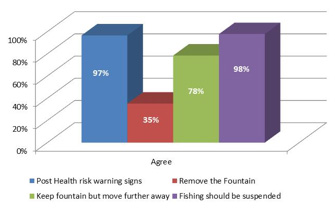
Each summer a fountain is installed by the City at the south end of the lake close to the viewing dock. There is concern that the fountain may contribute to the risk of airborne cyanobacteria and in windy conditions water sprays on visitors on the viewing dock. 35% felt the fountain should be removed but if not removed 78% felt it should be moved further into the lake.
Future Outcomes
Three possible future long term outcomes were outlined at the meeting. One outcome involved partially draining the lake and turning the area into a wetland. The second involved continuing with the status quo of periodically applying chemical treatments that will reduce the phosphorus and cyanobacteria. The third option involved investment in long term sustainable solutions and a program for restoration of the lake and park.
81% of respondents felt that turning the area into a wetland would be a bad outcome. 11% felt that a wetland would be an acceptable outcome and only 5% felt it would be the desired outcome.
If the lake was to maintained as is, only 32% felt the current policy of focusing on containing cyanobacteria risk was the desired outcome while 56% felt that a policy designed to prevent further deterioration in water quality was a desired objective.
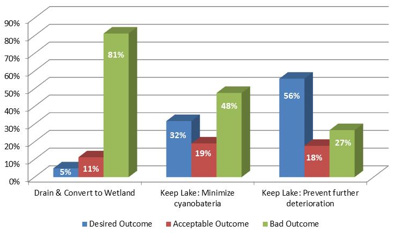
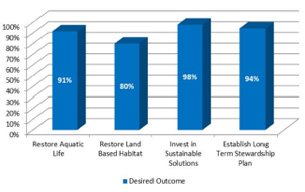
The preferred policy was clearly to initiate a policy that involved investment in sustainable solutions and restoration of the aquatic and land based habitat. 98% supported the investment in long term sustainable solutions, 91% supported restoration of the aquatic life in the lake, while 80% supported restoration of the land based habitat. 94% felt that it was important to establish a long term Stewardship Plan for Swan Lake and Swan Lake Park.
The original vison for Swan Lake included canoeing and kayaking, ice skating and fishing as recreational activities on the lake. This has not materialized. 45% of respondents said they would like to see canoeing and kayaking on the lake while 54% would like to see ice skating. There was less support for sport fishing – 31% supported sport fishing while 69% were opposed to sport fishing on the lake.
Assessment of Markham’s Role as Steward of Swan Lake Park
Availability of Recreational Amenities
Respondents provided positive responses on a range of recreational amenities in Swan Lake Park. 65% rated the availability of children’s play areas as either good or very good while another 26% rated it as acceptable. Similarly, 55% rated the availability of walkways as good or very good and another 30% rated the availability of walkways as acceptable.
29% rated the accessibility to the lake as acceptable while 48% felt accessibility was either poor or in need of improvement. Similarly, 29% felt the ability to view the lake as acceptable while 49% rated the viewing ability as either poor or in need of improvement.
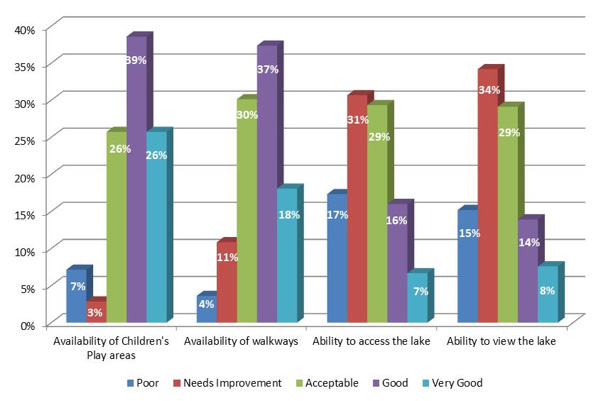
Maintenance of Recreational Amenities
The respondents provided a positive assessment of the City’s maintenance of the children’s play areas – 65% rating the maintenance as good or very good and another 25% assessed the maintenance as acceptable. 70% rated the maintenance of the walkways as acceptable or better; however 26% felt there was need for improvement.
10% rated the overall park maintenance as poor while another 36% reported that there was a need for improvement. 33% found the level of maintenance acceptable while 22% rated the overall park maintenance as good or very good.
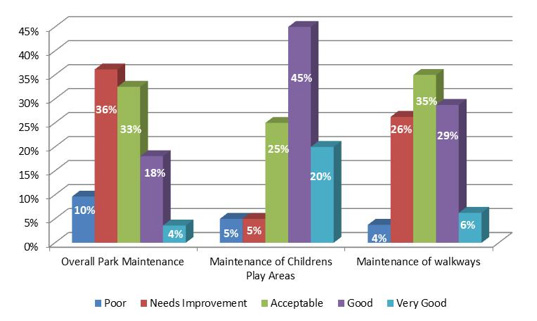
Maintenance of Environmental Elements
The assessment of the environmental elements was much lower than the rating for the recreational elements in the park.
90% rated the maintenance of fishing in the park as poor. 92% rated the maintenance of water based habitat as poor or in need of improvement.
39% rated the land based elements as being poor or in need of improvement whereas 56% rated the care of land based elements as acceptable or good.



